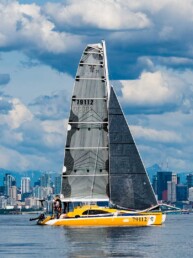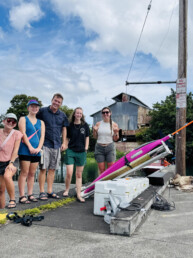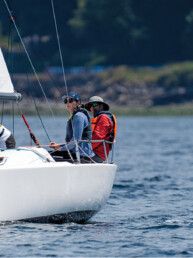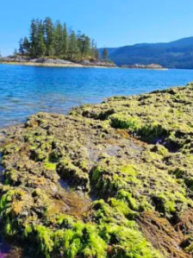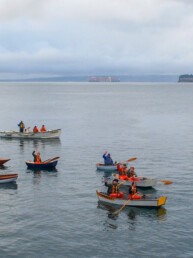
The atmosphere aboard the Schock 40 hurtling upwind in the dark through the Johnstone Strait was trepidatious, as the gentle hum of a motor carried forth on the lips of the churning sea, a sound barely audible above the howling, 30-knot wind. Lurching out of the tumultuous night was a vessel lacking navigation lights, thoroughly perplexing Team Angry Beaver as they approached—you guessed it—Beaver Point.
As the spritely craft drew closer, it became evident that this was no ordinary vessel. A Russell Brown creation captained by an enigmatic friend of the Port Townsend legend, the boat that snuck up on the Angry Beavers was a 25-foot power outrigger. This hyper-efficient craft was extraordinarily stable with its ama, and casually did donuts around the team as they thrashed against the heavy wind and sea state on their way to victory in the 2019 Race to Alaska.
For one Angry Beaver in particular, Gavin Brackett, this chance encounter with Russell’s design was particularly inspiring, sparking the inescapable question: “How do I build one?”
There was boatbuilding precedent in Gavin’s family, cultivated before he was born. In 1987, Gavin’s parents, Bruce and Julia, as well as his older brother, Angus, began the painstaking, 10-year construction of the family’s 40-foot wooden cutter, Fiona, a beautiful vessel and story which deserves an article all its own.
When it came to Gavin constructing his own boat, he wanted to pursue a route simultaneously traditional and unconventional—a wooden vessel, much like the craft his family built, but also something unique, efficient and most importantly, fast. Fortunately, Paul Bieker and Russel Brown would come to develop plans for a 25-foot outboard-powered outrigger that checked all of those boxes, while simultaneously honoring the traditional Austronesian sailing proa, the world’s first ocean-going vessel dating back to at least 2200 B.C.

Middle: Once the inner structure was built, the ama’s deck was next.
Right: Throughout the build, Gavin leaned on savvy and generous friends and family, first assembling the hull pieces at the home of an R2AK teammate.
Unlike the traditional proas of ancient sailors, however, this one would technically be an outrigger, since it can travel with its ama to leeward; whereas true proas must keep their ama to windward, tacking by shunting, or changing ends. Eventually christened as Surf Scoter, Gavin’s outrigger, also unlike most other proas, would be constructed with African mahogany plywood sections, CNC-cut courtesy of Evan Walker at Betts Boats in Anacortes. It would then be configured together like the pieces of a massive puzzle and sealed with six-ounce fiberglass cloth and epoxy. And, much like the average Washington State Ferry tabletop puzzle, Surf Scoter also lacked an instruction manual—but this was truly a puzzle worth solving.
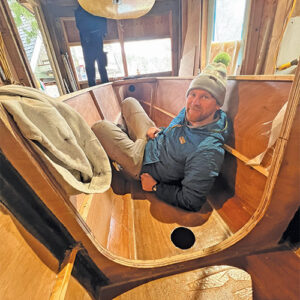
Deciding to complete a puzzle is, of course, the easy part. The challenge of how to make it logistically feasible is, inevitably, much more difficult. The preliminary conundrum for Gavin in the Surf Scoter endeavor consisted of where to build it and, over the years, its answer would prove to be four-fold. The first stop in Surf Scoter’s journey was at fellow Angry Beaver Matt Pistay’s South Sound residence, where Gavin commenced construction by gluing together the CNC puzzle joints of the main hull’s panels. After the joints cured, Gavin sheathed the inside surfaces of the panels, blanketing each in fiberglass cloth and epoxy. Once the main hull pieces were taken care of, he moved on to the other parts of his wooden enigma. This is when Gavin decided to move his project a little closer to home, which brings us to stop number two in Surf Scoter’s expedition.
Strapping the panels of his future boat onto the roof of his brother’s pickup truck, Gavin prepared to, quite literally, set up shop on his family’s Orcas Island property. Upon arrival, he established a full-on workshop with just the right dimensions necessary to house the outrigger’s main hull, much like a shoe would fit in a shoebox, with a cupola on the second story to live in. One of my first “dates” with Gavin consisted of the two of us, plus several of our industrious friends, raising the first wall of the workshop—a monumental step in Surf Scoter’s construction, as well as in our relationship.
Once the shop was built, Gavin got to work with a rather sensible order of operations. Assemble the ama first, becoming practiced in the process, and then proceed onto the main hull which, according to Gavin, demanded a much greater level of precision. In the construction of both hulls, Gavin fastened the stringers to their respective side panels, bent the two bows into place, and then inserted the bulkheads. This was all secured together with screws that were removed later, filling the holes with epoxy. To connect it all together, Gavin built a jig for the construction of the two beams. After milling roughly 30 sheets of five-millimeter fir laminates, he bent them into place using clamps placed along the jig, contorting them into shape, before commencing the extensive fairing and sheathing processes.
All the while, Gavin was intensely focused on the alignment of the vessel, and rightfully so. On the micro scale, Gavin had to laser-align the main bulkheads, ensuring they were perfectly square within the broader structure of the boat. Then, on the macro level, he had to laser-align both hulls together, guaranteeing the vessel would float properly once splashed. It was for this orientation component that Surf Scoter made its third stop: to our friend, mentor, and Farrier F-25C skipper, Nige Oswald’s shop on San Juan Island. No stranger to the construction of multihulls, Nige graciously offered his space for this crucial step in the building process. Having enough room to maneuver the 10-foot-wide Surf Scoter amidst alignment lasers was truly and literally pivotal in the completion of the construction process, and our gratitude to Nige knows no bounds.
When the alignment process was complete, Gavin glued the ama to its beams, and then bolted the outrigger assembly to the main hull using four stainless bolts, secured with G10 backing plates. This configuration essentially means the outrigger can be quickly retracted against the main hull, making the boat a perfect candidate for trailering. Case in point, we then loaded the boat to its trailer before returning Surf Scoter to her Orcas Island home, her fourth and final stop, for painting, finishing touches, and then, finally, launching Gavin’s labor of love.
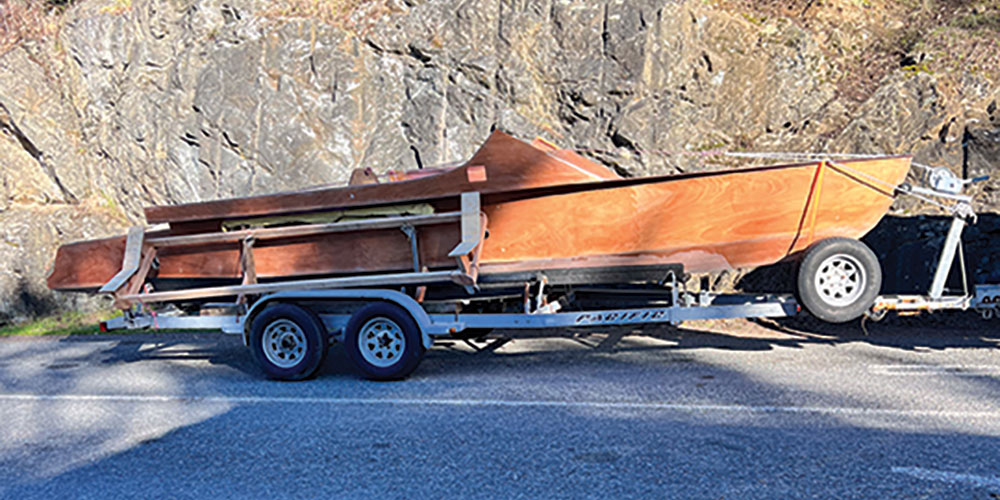
Over the course of Surf Scoter’s three-year construction, Gavin spent nearly 1,000 hours gluing, sanding, laminating, sanding, painting, sanding, varnishing, and sanding some more, tirelessly living his life according to epoxy curing and paint drying schedules. Even still, Gavin readily admits that his construction timeline could have been massively condensed had he simply focused on the task at hand. Instead, he spent months at a time racing various sailing vessels across the Atlantic and the Pacific to podium finishes, as well as delivering race mono- and multihulls through the Straits of Gibraltar and Malacca, amongst other awe-inspiring endeavors. As a result, he acknowledges that his next boat-building project will be completed at a much faster pace, especially now that he’s got Surf Scoter under his belt.
That said, Surf Scoter is still very much a work-in-progress, as all boats perpetually are. She’s currently fueled by a 25-horsepower Yamaha outboard with a tiller extension made from a windsurfing mast, an homage to Gavin’s sheer—and oftentimes hilarious—creativity, but Gavin’s future plans consist of upgrading his system to whip-staff steerage and a 30-horsepower motor, as well as a dodger to make wintertime adventures a little less damp. Moreover, he plans on fleshing out the outrigger’s water ballast system for exceptionally heavy winds and sea states. Using a gear pump so the ama can be emptied and filled from the comfort of the main hull, the outrigger will hold upwards of 27 gallons of seawater, which is approximately 200 extra pounds of ballast for added stability. But, in the meantime, Gavin has no concerns about the steadiness of his vessel, even in tumultuous conditions, as demonstrated by his “comfortable crossing” of Rosario Strait in a 20-knot wind through a beam-on sea state.
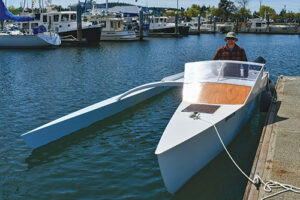
Luckily for the sake of my blood pressure, most of his sea trial experiences have been conducted in much calmer conditions. In the first 36 hours of having Surf Scoter in the water, Gavin effectively cruised over 200 miles around the San Juan Islands while using fewer than a dozen gallons of gas, camping on Stuart Island one evening and Sucia the next, with a trip up the slough to La Conner in between. All the while, Surf Scoter accelerates in a way that is hard to put into words. There’s no displacement, angular mode to her acceleration, as you would experience with most power boats. Instead, she slices through the water, like a pair of warm knives through butter and, as with most multihulls, 20 knots feels truly effortless. Thus, the beauty of Surf Scoter is her speed and efficiency in all conditions, providing a reasonable alternative to navigating the Salish Sea in a way that essentially renders I-5 irrelevant.
Our plans for the boat, of course, extend beyond our local waters. Surf Scoter is capable of reaching Desolation Sound from Bellingham in a matter of 8 hours, flying across the water at 16 knots, and consuming fewer than 10 gallons of gas in the process. All the while, she draws less than a foot; her miniscule draft means being able to navigate and anchor in the shallowest of waters, taking us to places that our J/36 with its 7-foot draft could only dream of. Moreover, her lightweight, compactable design (weighing in at fewer than 700 pounds, including her outboard) means being able to trailer her when we want to and, when she’s in the water, her outrigger creates a level of stability that inspires confidence in any conditions.
For a man whose boating experience began when he was still in the womb, it truly means the world to Gavin to be cruising his home waters on a boat he made himself, especially one that exemplifies speed and efficiency. While Surf Scoter’s construction was Gavin’s singlehanded effort, every project inevitably takes a village. In this case, the guidance of Russell Brown, Paul Bieker, and Angry Beaver teammate Simon Miles were instrumental to Gavin’s success. Moreover, the support provided by Nige Oswald, Julia and Bruce Brackett, and Gavin’s brother Angus, as well as by a number of other friends, was also pivotal to the realization of Gavin’s dream.
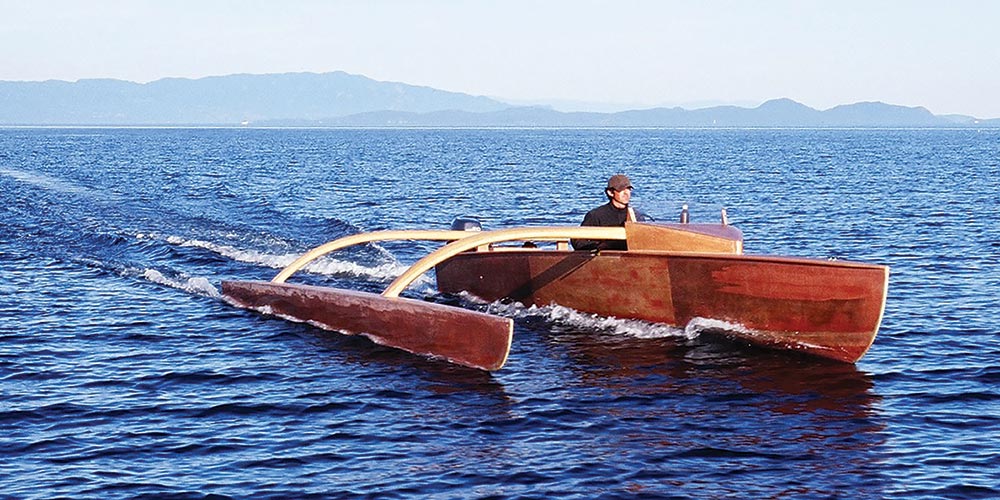
Speaking for both Gavin and myself, we cannot thank this community enough for your unending encouragement, assistance, and love. You all helped to make a dream a reality and, in this case, a dream sparked in circumstances as unique as they are pure PNW. Team Angry Beaver sailed home from Ketchikan five years ago, $10,000 in hand, but perhaps the real prize was the lasting inspiration for its team members to continue crafting and sailing faster, more innovative, and more efficient vessels under the tutelage of Pacific Northwest boat building legends like Russell, Paul, Bruce, and Julia.
Ryan Samantha Carson started life moving around as a military brat. In her early adulthood, she found her way to the Pacific Northwest and discovered sailing, and the rest is history. She’s the owner of a yacht management company, and this month begins a new job as 48° North’s advertising salesperson.

